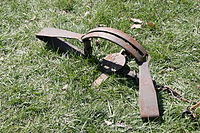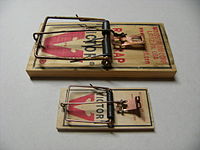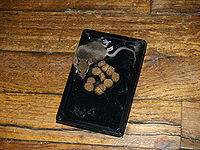- Animal trapping
-
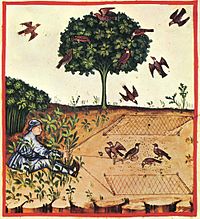 Trap nets used to trap birds (tacuinum sanitatis casanatensis); 14th century.
Trap nets used to trap birds (tacuinum sanitatis casanatensis); 14th century.
Animal trapping, or simply trapping, is the use of a device to remotely catch an animal. Animals may be trapped for a variety of purposes, including food, wildlife management, hunting, and pest control. Trapping may also specify the capture of mammals for their furs which may be sold or bartered in the fur trade, or which may used for making clothing and other articles.
Contents
History
Animal trapping is perhaps one of the first methods of hunting. Neolithic hunters, including the members of the Cucuteni-Trypillian culture of Romania and Ukraine (ca. 5500-2750 BC), used traps to capture their prey.[1] A passage from the self-titled book by Taoist philosopher Zhuangzi describes Chinese methods used for trapping animals during the 4th century BC. The Zhuangzi reads, "The sleek-furred fox and the elegantly spotted leopard...can’t seem to escape the disaster of nets and traps.”[2][3] "Modern" steel jaw-traps were first described in western sources as early as the late 16th century.[4] The first mention comes from Leonard Mascall's book on animal trapping.[5] It reads, "a griping trappe made all of yrne, the lowest barre, and the ring or hoope with two clickets." [sic][6] The mousetrap, with a strong spring device spring mounted on a wooden base, was patented in 1910 by James Henry Atkinson, a trap maker from Leeds, Yorkshire, England.
Trapping was widely done in the early days of North American settlements, companies such as the Canadian fur brigade were established. Native Americans trapped fur bearing animals with pits, dead falls, and rudimentary snares. Europeans learned from the native Americans when they first arrived in eastern North America how to trap animals with deadfalls and pits. Leghold traps were later made in the 18th century by blacksmiths for trappers who requested that traps be made for them. In the mid 19th century, trap companies became established, making traps and fur stretchers.
The monarchs and trading companies of Europe invested heavily in voyages of exploration. The race was on to establish trading posts with the natives of North America, as trading posts could also function as forts and legitimize territorial claims. The Hudson's Bay Company was one such business. They traded commodities such as rifles, pistols, knives, food, frying pans, pots or blankets were exchanged for furs from trappers and Native Americans.
Trappers and mountain men were the first European men to cross the Great Plains to the Rocky Mountains in search of fur. They traded with Native Americans from whom they learned hunting and trapping skills.
Beaver was one of the main animals of interest to the trappers as the fur wore well in coats and hats. Beaver hats became popular in the early 19th century but later the fashion changed. Towards the end of the century beaver became scarce in many areas and extirpated in others. The decline in key species of fur-bearers, due to over-harvesting, and the later emergence of the first regulatory laws marked the end of the heyday of unregulated trapping. Many trappers turned to buffalo hunting, serving as scouts for the army or leading wagon trains to Oregon, California and other parts of the American west. The trails that trappers used to get through the mountains were later used by settlers heading west.
Reasons for trapping
Trapping is done for a variety of reasons. Mostly it is practiced for food or fur, but sometimes it is done for wildlife management or pest control. Fur-bearing mammals are targeted for their fur to be used in clothes and other articles. The dead animals are skinned, and the fur is used to make clothes or is sold or bartered.
For fur
A fur trapper is a person whose employment occupation involves the trapping of animals for their fur. In the early days of the colonization settlement of North America, the trading of furs was common between the settlers and the local Indians. Many locations at which trading took place were referred to as trading posts.
Trapping continues to be a profession in many areas around the world, although relatively few people make a full-time living from it. Competition from fur farming and fluctuating populations of wild animals have made trapping a minor industry. Fur prices have trended downward for many years, while costs have gone up, resulting in a dramatically lessened economic incentive.
Some species have collapsed to such an extent, in some locations, that harvesting them is entirely prohibited, particularly in the continental United States and in many parts of southern and western Europe. This is especially true of predator species such as the Canadian Lynx in much of the US[7]. Yet certain other fur-bearing species, including beaver and coyote, have shown dramatic population increases in certain regions.
Popular quarry of fur trappers are: beaver, raccoon, wolverine, mink, ermine, American marten, bobcat, lynx, and muskrat.
For food
Animals may be trapped for food. Animals commonly trapped for food include rabbits, opossum, and raccoon.
Damage prevention
Animals are frequently trapped in many parts of the world to prevent damage to personal property, including the killing of livestock by predatory animals.
Other reasons
Animals may also be trapped for public display, for natural history displays, or for such purposes as obtaining elements used to the practice of traditional medicine.
Use of traps
Trapping requires time and energy but can be very efficient. Trapping may be safe and inexpensive for the trapper, but in modern times it has become controversial, because of its alleged cruelty. In part to address these concerns, in 1996, the Association of Fish and Wildlife Agencies, an organization made up of state and federal fish and wildlife agency professionals, began testing traps and compiling recommendations “to improve and modernize the technology of trapping through scientific research” known as Best Management Practices.[8] As of October 2008, best management practice recommendations for trapping 10 common furbearers had been published.[9]
Trapping is regularly used for pest control most commonly of beaver, coyote, raccoon, cougar, bobcat, Virginia opossum, fox, rat, mouse and mole in order to limit damage to households, food supplies, farming, ranching, and property. Proponents claim that trapping can reduce numbers of predators in order to increase the populations of quarry species for hunting. They also claim that it can be used to control over population. Trapping is also used for research and relocation of wildlife.[10] Federal authorities in the United States use trapping as the primary means to control predators that prey on endangered species such as the San Joaquin kit fox (Vulpes macrotis mutica), California least tern (Sterna antillarum browni) and desert tortoise (Gopherus agassizii).[11]
Many wildlife biologists support the use of regulated trapping for sustained harvest of some species of furbearers. They claim that trapping can be an effective method of managing or studying furbearers, controlling damage caused by furbearers, and at times reducing the spread of harmful diseases. These biologists believe that regulated trapping is a safe, efficient, and practical means of capturing individual animals without impairing the survival of furbearer populations or damaging the environment. They also support regulatory and educational programs, research to evaluate trap performance and the implementation of improvements in trapping technology in order to improve animal welfare.[12]
Despite regulations, negligent trappers sometimes leave traps unattended for long periods of time and trap animals out of season, leading to fines, restitution and trapping license revocations.[13][14]
Traps
Most of the currently used traps used for mammals can be divided into five types: foothold traps, body gripping traps, snares, cages, and glue traps.
Foothold traps
An offset leghold trap designed for catching bears, sprung position.
Probably most commonly associated with trapping, the foothold trap is made up of two jaws, one or two springs, and a trigger in the middle which is usually a round pan. When the animal steps on the trigger the trap closes around the foot, preventing the animal from escaping. Usually some kind of lure is used to position the animal, or the trap is set on an animal trail. Foothold traps set for beaver, mink, river otter, and muskrat are positioned in shallow water along the shores and banks of rivers, lakes and ponds. Sometimes the trap is attached to a weight sunk in deeper water. The animal, when caught by the foot, tries to escape by diving into deep water and drowns. Traditionally, these traps had tightly closing jaws to make sure the animal stayed in place. These traps are made in various sizes from catching weasels to bears. At one time traps for wolves and bears had rounded teeth on the jaws to prevent escape.
Modified traps are now available with offset jaws, or lamination, or both, both of which decrease pressure on the animals legs. Traps are also available with a padded jaw, which has rubber inserts inside the jaws to reduce animal injuries.[15] However these traps are more expensive and not widely employed except by research and conservation experts.[16] A single number 3 foothold trap which has a 6 inch jaw spread and commonly used for trapping beaver and coyote costs about 10 to 15 dollars depending on the make, while a padded jaw or "Soft Catch" trap cost from 12 to 20 dollars.[17] Today's traps are specially designed in different sizes for different sized animals which trappers and trap manufacturers claim also reduces injuries.[18] Anti-fur campaigns have protested leghold traps on grounds that animals caught in leghold traps will frequently chew off their leg to escape the trap[19], while the National Animal Interest Alliance states that modern foothold traps have been designed to hold animals as humanely as possible to reduce incidences of the animal fighting the trap, possibly injuring itself or getting loose in the process.[20]
In states that have banned the use of the foothold trap, a number of issues have arisen. In Massachusetts, the beaver population increased from 24,000 in 1996 to over 70,000 beaver in 2001.[21] Coyote attacks on humans rose from 4 to 10 per year, during the five year period following a 1998 ban on leghold traps in Southern California.[22]
Manufacturers of newer types of traps designed to work only on raccoons claim that these traps are dog-proof. These traps are small, and rely on the raccoon's grasping nature to trigger the trap. They are sold as coon cuffs, bandit busters and egg traps just to name a few.[23]
Body gripping/conibear traps
The body gripping traps are traps designed to kill the trapped animal quickly. They are frequently called "Conibear" traps after Canadian Frank Conibear who first constructed this type of trap in 1957. This type of trap was considered by trappers[who?] one of the greatest innovations in traps in the 20th century. Animals were quickly killed and therefore no animal could escape once caught. The animal must be lured with a bait or guided into the correct position before the trap is triggered. The animal touches the wire triggering mechanism which springs the trap. The trap is designed to close on the neck or torso of the animal which closes the trachea, and usually fractures the spinal column. Animals die in one to two minutes. The trap is made from round bar steel and comes in several sizes. One size is 5 by 5 inches (130 by 130 mm) square shaped, for muskrats and mink. Another is 7 by 7 inches (180 by 180 mm) for raccoons and possums. The third is 10 by 10 inches (250 by 250 mm) for beaver and otter. Conibear traps are mostly used to trap muskrats or beaver.
A golden eagle was also documented to have been killed in a conibear trap in January 2008 in Montana.[24]
Deadfall traps
A deadfall is a heavy rock or log that is tilted on an angle and held up with sections of branches (sticks), with one of them that serves as a trigger. When the animal moves the trigger which may have bait on or near it, the rock or log falls, crushing the animal. The figure-four deadfall is a popular and simple trap constructed from materials found in the bush (three sticks with notches cut into them[clarification needed], plus a heavy rock or other heavy object). Also popular, and easier to set, is the Paiute deadfall, consisting of three long sticks, plus a much shorter stick, along with a cord or fiber material taken from the bush to interconnect the much shorter stick (sometimes called catch stick or trigger stick) with one of the longer sticks, plus a rock or other heavy object.[25]
Snares
Snares are anchored cable or wire nooses set to catch wild animals such as foxes, rabbits, and coyotes. In the UK, they are commonly used for population control, but are used as well at times for food collection (e.g., rabbits) or for research.[26] In the USA, they are most commonly used for capture and control of surplus furbearers, and, especially, for food collection. They are also widely used by subsistence and commercial hunters for bushmeat consumption and trade in African forest regions.[27]
Snares are one of the simplest traps and are very effective.[28] They are cheap to produce and easy to set in large numbers. A snare traps an animal around the neck or the body and tightens around the animal, restraining it. Snares are widely criticised by animal welfare groups for their alleged cruelty.[29] UK users of snares accept that over 40% of animals caught in some environments will be non-target animals, although non-target captures range from 21% to 69% depending on the environment.[26] In the USA, non-target catches reported by users of snares in Michigan were 17 +/- 3%.[30] Some scientists believe that in animals which are trapped, pressure necrosis may have caused hidden injury to the animal, and that trapped animals should be taken to a vet rather than released.[31] However, trappers claim that modifications now provide working snares that have relaxing locks that do not cinch down, break-away locks that open up after 110 kg of force are exacted, deer stops which prevent the snare from closing down so far as to catch a deer's leg, and live-catch stops that prevent the snare from closing to a point that chokes an animal of a certain size.[citation needed]
Snares are regulated in many jurisdictions, but are illegal in other jurisdictions, such as in much of Europe. Different regulations apply to snares in those areas where they are legal. In Iowa, snares have to have a 'deer stop' which stops a snare from closing all the way. In the United Kingdom, snares must be 'free-running' so that they can relax once an animal stops pulling, thereby allowing the trapper to decide whether to harvest[32][33] the animal or release it. Following a consultation on options to ban or regulate the use of snares,[34] the Scottish Executive announced a series of measures on the use of snares, such as the compulsory fitting of safety stops, ID tags and marking areas where snaring takes place with signs.[35] In some jurisdictions, swivels on snares are required, and dragging (non-fixed) anchors are prohibited.[36][37]
Trapping pit
Trapping pits are deep pits dug into the ground, or built from stone, in order to trap animals. Like cage traps they are usually employed for catching animals without harming them.
Cage traps (live traps)
 Cage trap with shade cloth to protect animal from heat.
Cage trap with shade cloth to protect animal from heat.
Cage traps are designed to catch live animals in a cage. They are usually baited, sometimes with food bait and sometimes with a live "lure" animal. Cage traps usually have a trigger located in the back of the cage that causes a door to shut; some traps with two doors have a trigger in the middle of the cage that causes both doors to shut. In either type of cage, the closure of the doors and the falling of a lock mechanism prevents the animal from escaping by locking the door(s) shut. Supporters of cage traps say that they are the most humane form of trapping, and in some countries are the only method of trapping allowed. However studies have shown that animals restrained in cage traps may break claws or teeth, and skin their faces.[38] Cage traps are used by animal control officers to catch unwanted animals and move them to another location without harm, as well as by gamekeepers to catch birds and animals they consider to be pests, and which are killed after catching. Cage traps are also sometimes used for capturing small animals such as squirrels by homeowners in urban areas, such as in attics of homes, for removal to locations where they may either be legally killed and disposed of, or released unharmed. (Some municipal jurisdictions specifically prohibit transporting live squirrels and releasing them into other areas to control the spread of diseases; for these jurisdictions, killing the squirrels within the cage quickly and humanely is the only legal and ethical means of disposing of them.) Cage traps are also useful in catching large dangerous animals for transport and are a favourite of Australian crocodile trappers. Due to their bulk and cost, they are hard to set in great numbers or in remote locations. Cage traps are also used in muskrat trapping. A cage trap is set in a runway and the muskrat pushes the door open which is at a 45 degrees. But once the muskrat enters the cage trap the other side is closed with another door at 45 degrees. So the muskrat drowns in the trap which is set under water. No bait is necessary as trap is set in muskrats runway.
Glue traps
Glue traps made using natural or synthetic adhesive applied to cardboard or similar material. Bait can be placed in the center or a scent may be added to the adhesive. Glue board traps are used primarily for rodent control indoors. Glue traps are not effective outdoors due to environmental conditions (moisture, dust) making the adhesive ineffective. Glue traps are not used by animal trappers or fur trappers and are almost exclusively used by homeowners for rodent control.
Of note, animals unfortunate enough to find themselves captured in glue traps can be released by carefully applying cooking oil or baby oil to the contact areas and gently worked until the animal is free. This action would be deemed as a compassionate rescue rather than a design of (or justification for) this type of trap.
Many animal rights groups, such as the Humane Society, oppose the use of glue traps for their cruelty, since animals desperate to escape may chew off their own legs, and sizable sections of fur and skin may be ripped out as they struggle. Glue traps are typically not used for trapping birds, however a substance known as birdlime was used in the past in a similar manner to catch small birds, its use is banned now in most countries. In spite of this, the use of glue traps for catching birds is still prevalent in some countries such as Spain, in spite of being illegal. A sticky repellent can be applied to surfaces to temporarily repel perching birds from building ledges and statues. The adhesives registered for this use are classified as tactile repellents.
Unwanted catches
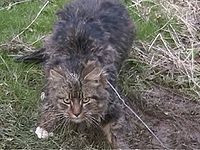 Non-target animals can be caught in snares
Non-target animals can be caught in snares
Trappers can employ a variety of devices and strategies to limit this problem. Trappers claim that if a non-target animal is caught, such as a dog, bobcat or lynx, it can be released without harm. A careful choice of lures may help draw wanted catch, and discourage the unwanted. Even if a variety of strategies, and careful choice of lures is applied, trappers cannot guarantee that unwanted animals won't be caught. Setting correctly and with in the laws all unwanted catches should be released unharmed.
Other exclusion devices exist for snares. The catching of non-target animals can be minimized through the use of devices that exclude animals larger than the target animal. Deer stops are designed to release leg-snared deer and cattle, and are required for snare usage in many states of the USA. Precautions can be taken in the case of small animals as well. One UK report stated that researchers using 1.65 mm smooth wire, instead of the larger 2 mm standard wire, had brown hares caught about as frequently as foxes, with about half of those hares being released unharmed,[39] (section 2.7) The UK report goes on to say that using the standard, larger wire in addition to equipping the snares with rabbit stops eliminated the unwanted catch of brown hares.
Types of sets
The most productive set for foothold traps is the dirt hole. The basic dirt hole is merely a hole dug in the ground with a trap positioned in front of the hole. An attractant is then placed inside the hole. The hole for the set is usually made in front of some type of object which is where medium-sized animals such as coyotes, fox or bobcats would use for themselves to store food. This object could be a tuft of taller grass, a stone, a stump, or some other natural object. The dirt from the hole is sifted over the trap and a lure applied around the hole.
A flat set is another common use of the foothold trap. It is very similar to the dirt hole trap set, simply with no hole to dig. The attractant is placed on the object near the trap and a urine scent sprayed to the object. The cubby set simulates a den in which a small animal would live, but could be adapted for larger game. It could be made from various materials such as rocks, logs or bark, but the back must be closed to control the animals approach. The bait and/or lure is placed in the back of the cubby. This is ideal for fur bearers like raccoons, opossums, and skunks.
The water set is usually described as a body-gripping trap or snare set so that the trap jaws or snare loop are partially submerged. The conibear is a type of trap used in water trapping and can also be used on land and is heavily regulated. The regulations vary from jurisdiction to jurisdiction. It is normally used without bait and has a wire trigger in the middle of it's square-shaped, heavy-gauge wire jaws. It is placed in places that are frequented by the fur bearing animals. They are excellent for beaver and muskrat.
These types are not all inclusive, but a good representation of those types of traps in use and some of the possibilities which are only limited by one's imagination and your local laws.See also
- Animal population control
- Big Game Hunter
- Bird trapping
- Bottle trap
- Bush meat
- Cannon netting
- Duck Hunting
- Endangered species
- Fish trap
- Fox hunting legislation
- Game Warden
- Hunter-gatherer
- Hunting
- Insect collecting
- Malaise trap
- Mouse Trap
- Ornithology
- Persistence hunting
- Pitfall trap
- Rocket net
- Trapping pit
- Wildlife
- World Hunting Association
References
- ^ Ștefan Cucoș Faza Cucuteni B în zona subcarpatică a Moldovei Muzeul de Istorie Piatra Neamț 1999
- ^ Zhuangzi, and Burton Watson. The Complete Works of Zhuang Zi. New York: Columbia University Press, 1968 (ISBN 0-231-03147-5), pp. 20-21
- ^ Chinese: 道:"丰狐,文豹……不免于网罗机辟之患"
- ^ Natural History of Beavers
- ^ Leonard Mascall (Oxford Dictionary)
- ^ Mascall, Leonard. A Book of Fishing with Hook and Line: Another of Sundrie Engines and Trappes to take Polecats, Buzzards, Rates, 1590.
- ^ 65 Federal Register 16051 16086[http://mountain-prairie.fws.gov/species/mammals/lynx/ Canada Lynx - U.S. FWS. (PDF) . Retrieved on 2011-09-16.
- ^ Best Management Practices
- ^ Association of Fish and Wildlife Agencies Best Management Practices
- ^ "Trapping for Research and Reintoduction". Anr.state.vt.us. http://www.anr.state.vt.us/furbearer/popup/reintro.html. Retrieved 2009-06-15.
- ^ Digitalcommons.unl.edu
- ^ Joomla.wildlife.org
- ^ Dozens of dead animals seized from MN trapper
- ^ Poacher fined $1,700, license suspended (August 5, 2008)
- ^ Digitalcommons.unl.edu
- ^ Siemer W. F., Batcheller G. R., Glass R. J. et al. Characteristics of trappers and trapping participation in New York. Wildl Soc Bull 1994;22:100-111.
- ^ R-P outdoors Fall/Winter 2008-2009 catalog
- ^ "Association of Fish&Wildlife Agencies". Fishwildlife.org. http://www.fishwildlife.org/furbearer_bmp.html. Retrieved 2009-06-15.
- ^ "Coalition to Abolish the Fur Trade". Caft.org.uk. http://www.caft.org.uk/factsheets/trapping.html. Retrieved 2009-06-15.
- ^ Stephen Vantassel (2009). "Animal Rights Activists Gloss Over Trapping Facts". Naiaonline.org. http://web.archive.org/web/20090629232524/http://www.naiaonline.org/articles/archives/trapfact.htm. Retrieved 2011-07-31.
- ^ Massachusetts Division of Fisheries and Wildlife (2007-09-20). "MassWildlife - Managing Beaver". Mass.gov. http://www.mass.gov/dfwele/dfw/wildlife/facts/mammals/beaver/beaver_management.htm. Retrieved 2009-06-15.
- ^ "Coyote Attacks: An Increasing Suburban Problem". Repositories.cdlib.org. 2004-03-03. http://repositories.cdlib.org/anrrec/hrec/timm_baker_P047/. Retrieved 2009-06-15.
- ^ "NTA - Trapping Facts". Nationaltrappers.com. 2002-09-15. http://www.nationaltrappers.com/facts.html. Retrieved 2009-06-15.
- ^ Montana Dog Owners Find Wild-Animal Traps Put Pets in Harm’s Way
- ^ U.S. Army (June 1992). "Food Procurement (Chapter 8)". U.S. Army Survival Manual FM 21-76. U.S. Army. pp. 8–19, 8–20. http://www.equipped.org/21-76/ch8.pdf.
- ^ a b James Kirkwood (August 2005). "Report of the Independent Working Group on Snares" (PDF). Defra. http://www.defra.gov.uk/wildlife-countryside/pdf/wildlife-manage/snares-iwgs-report.pdf. Retrieved 2009-04-16.
- ^ "CJO - Abstract - Cable snares and bushmeat markets in a central African forest". Journals.cambridge.org. 2002-05-10. http://journals.cambridge.org/action/displayAbstract?fromPage=online&aid=38311&fulltextType=RA&fileId=S0376892998000289. Retrieved 2009-06-15.
- ^ Andelt, William F. (1993). Publication No. 6.517 Proper use of snares for capturing furbearers. Colorado State University Cooperative Extension. http://www.cdc.gov/nasd/docs/d000101-d000200/d000129/d000129.pdf. Retrieved 2009-04-16.
- ^ "League Against Cruel Sports : Snaring". League.org.uk. http://www.league.org.uk/content.asp?CategoryID=1253. Retrieved 2009-06-15.
- ^ Michigan.gov
- ^ "Badgers". Sttiggywinkles.org.uk. http://www.sttiggywinkles.org.uk/badgers.html. Retrieved 2009-06-15.
- ^ "Canadian Wildlife Federation :: The Canadian Wildlife Federation". Spaceforspecies.ca. http://www.spaceforspecies.ca/glossary/h.htm. Retrieved 2009-06-15.
- ^ "Governance By-law Samples: Sample Hunting By-law". Ainc-inac.gc.ca. 2008-11-03. http://www.ainc-inac.gc.ca/ap/gov/ce/gv/sh-eng.asp. Retrieved 2009-06-15.
- ^ Scotland.gov.uk
- ^ "UK | Scotland | Ministers reject snare ban plea". BBC News. 2008-02-20. http://news.bbc.co.uk/1/hi/scotland/7252665.stm. Retrieved 2009-06-15.
- ^ Wisconsin Cable Restraints and Snare Regulations
- ^ Michigan Fox & Coyote Non-Lethal Snaring Guide
- ^ Animal Abuse and Unlawful Killing: Forensic Veterinary Pathology P 77. By Ranald Munro, Helen M. C. Munro.
- ^ Defra.gov.uk
 This article incorporates text from a publication now in the public domain: Chisholm, Hugh, ed (1911). Encyclopædia Britannica (11th ed.). Cambridge University Press.
This article incorporates text from a publication now in the public domain: Chisholm, Hugh, ed (1911). Encyclopædia Britannica (11th ed.). Cambridge University Press.
External links
- Camp Life in the Woods and the Tricks of Trapping and Trap Making by William Hamilton Gibson, from Project Gutenberg
- Traps and Snares Collection
- Wildwood Survival: How to construct a Figure-4 deadfall trap
- League Against Cruel Sports, cruel and indiscriminate snares
- Joint Industry Briefing: The importance of snaring (Scotland)en:Animal trapping
Wikimedia Foundation. 2010.

